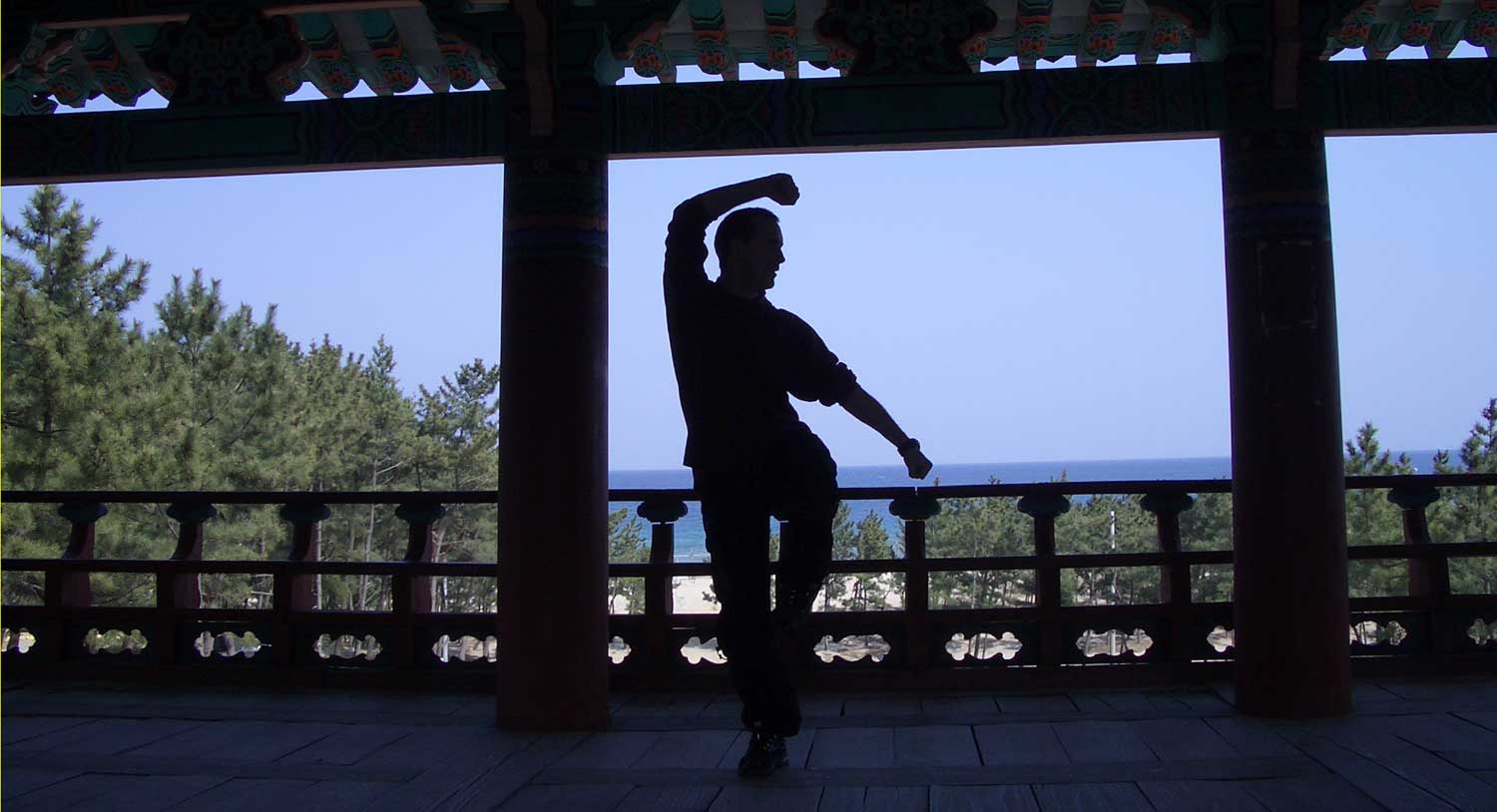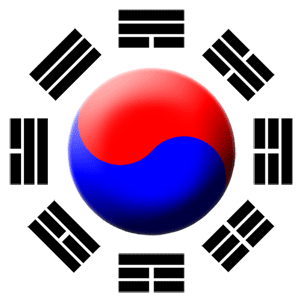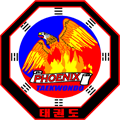At the Heart of the Taegeuk The Philosophy behind the Patterns
At the heart of Taekwondo are the Taegeuks, the 8 basic training patterns. On the surface the Taegeuks are simply an efficient means of grading students with one being learnt for every grading but what is the deeper meaning behind the Taegeuks and the way in which they are performed ? Every Taekwondo student knows that to pass their next grading they first have to learn their next pattern. Within the Kup grades (up to Black Belt) there are 8 patterns to learn, these are the Taegeuks. Not surprisingly these patterns have not just been created out of nothing, rather they are interwoven with the philosophy and origins of Taekwondo itself.

 The word Tae-Geuk is constructed from the symbol Tae, meaning bigness and the symbol Geuk, meaning eternity, thus the Taegeuks encompass all that is within Taekwondo. Each of the eight Taegeuks represent an image or 'way of thought'. To explain the origin and meaning of the Taegeuks we must look to ancient oriental philosophy for the answers. The Yin-Yang symbol (Um & Yang in Korean) is a very common, an almost fashionable sight these days but what does it really represent? The two sides of Yin & Yang depict the two opposite elemental forces :- Light & Dark, Creative & Receptive, Hard & Soft, etc. From these two forces all other emotions and elements can be created using different combinations of the two. The circles of opposite colours within the Yin and the Yang and to show that within darkness there is always light and within light there is always darkness. The circular nature of the Yin-Yang symbol symbolizes that everything within the Universe is always in constant motion but in harmony.
The word Tae-Geuk is constructed from the symbol Tae, meaning bigness and the symbol Geuk, meaning eternity, thus the Taegeuks encompass all that is within Taekwondo. Each of the eight Taegeuks represent an image or 'way of thought'. To explain the origin and meaning of the Taegeuks we must look to ancient oriental philosophy for the answers. The Yin-Yang symbol (Um & Yang in Korean) is a very common, an almost fashionable sight these days but what does it really represent? The two sides of Yin & Yang depict the two opposite elemental forces :- Light & Dark, Creative & Receptive, Hard & Soft, etc. From these two forces all other emotions and elements can be created using different combinations of the two. The circles of opposite colours within the Yin and the Yang and to show that within darkness there is always light and within light there is always darkness. The circular nature of the Yin-Yang symbol symbolizes that everything within the Universe is always in constant motion but in harmony.
The Taegeuks are given their meaning in the ancient work the book of changes (known as I' Ching by the Chinese and Jooyeok by the Koreans). The book of changes defines eight different combinations of Yin & Yang and it is these manifestations that the Taegeuks represent.
Each manifestation is given a symbol or Trigram. This is a combination of Yin and Yang represented by three solid or broken bars. Four of the eight Trigrams are part of the Korean flag. As well as a Trigram, each combination manifests itself as an image or element (Heaven, Lake, Fire, Thunder, Wind, Water, Mountain or Earth) and an impression or attribute (Strength, Joy, Yielding, Movement, Penetrating, Dangerous, Resting or Devotion). The Taegeuk training patterns are practised with these attributes in mind and should in fact shape the attitude of the student as they perform the pattern.
The Taegeuks and their associated meaning are listed in the table below. The actual names of the Taegeuks simply mean first training pattern, second training pattern etc.( Il means first, Pal means eighth) but each pattern has its own individual personality and meaning and are ordered with the students progression through Taekwondo in mind.
| Name | Trigram | Symbolism | Attribute | Image | |
|---|---|---|---|---|---|
| 1 | iljang | Keon | creative | Strength | Heaven |
| 2 | iijang | Tae | joyous | Joyful | Lake |
| 3 | samjang | Ri | clinging | Yielding | Fire |
| 4 | sajang | Jin | arousing | inciting | Thunder |
| 5 | ohjang | Seon | gentle | Penetrating | Wind |
| 6 | yookjang | Gam | abysmal | Dangerous | Water |
| 7 | chiljang | Gan | stillness | Resting | Mountain |
| 8 | paljang | Gon | receptive | Devotion | Earth |
The Trigrams are arranged in a circle around the Yin-Yang symbol in such a way that symbols on opposite sides of the circle are 'mirrors' of each others nature . For example, the top Trigram - Keon - is pure Yin and represents heaven. Opposite this (the bottom Trigram) is the symbolism of pure Yang - Gon - the Earth. Fire - Ri - is opposite water - Gam and joy - Tae - is opposite calm/stillness - Gan. Thunder (noise without force) - Jin - is opposite wind - Seon - (force without noise).
Find out more about the Trigrams by clicking below:
 Heaven: The 3 solid lines symbolize sky. The sky is strong and provides infinite space to accommodate everything.
Heaven: The 3 solid lines symbolize sky. The sky is strong and provides infinite space to accommodate everything.
 Lake: A broken line on top of two solid lines symbolize lake. The top broken line is water and the bottom 2 solid lines is sky reflected in the surface of the water.
Lake: A broken line on top of two solid lines symbolize lake. The top broken line is water and the bottom 2 solid lines is sky reflected in the surface of the water.
 Fire: The broken line between 2 solid lines symbolize fire. The 2 solid lines represent the movement of the fire. The broken line is the heart of the fire which is still.
Fire: The broken line between 2 solid lines symbolize fire. The 2 solid lines represent the movement of the fire. The broken line is the heart of the fire which is still.
 Thunder: The 2 broken lines symbolizes lighting striking on the top of a mountain (the bottom line). The bottom solid line represents elevation.
Thunder: The 2 broken lines symbolizes lighting striking on the top of a mountain (the bottom line). The bottom solid line represents elevation.
 Wind: The 2 solid lines on top a broken line symbolize wind. The 2 solid lines represent the sky and the broken line represents the earth.
Wind: The 2 solid lines on top a broken line symbolize wind. The 2 solid lines represent the sky and the broken line represents the earth.
 Water: The solid line between 2 broken lines symbolizes water with the 2 broken lines representing river banks.
Water: The solid line between 2 broken lines symbolizes water with the 2 broken lines representing river banks.
 Mountain: A solid line on top of 2 broken lines symbolizes the mountain. The solid line representing elevation sits atop of 2 bottom broken lines representing the earth.
Mountain: A solid line on top of 2 broken lines symbolizes the mountain. The solid line representing elevation sits atop of 2 bottom broken lines representing the earth.
 Earth: 3 broken lines symbolize the earth. Life begins and ends in the earth. The earth is receptive of all.
Earth: 3 broken lines symbolize the earth. Life begins and ends in the earth. The earth is receptive of all.
As can be seen the Taegeuks are not just random collections of Taekwondo techniques linked together into combinations but have their essence deeply rooted in the tradition and the philosophy behind the majority of all martial arts. Each Taegeuk has its own personality defined by a set of individual images and attributes. These are not simply laid randomly on the surface of the Taegeuks but are carefully ordered such that each new concept and set of new techniques provide the Taekwondo student with a natural progression from beginner to Black Belt. The next time you practice your patterns remember that there is a lot more to them than just physical exercise
return to top







